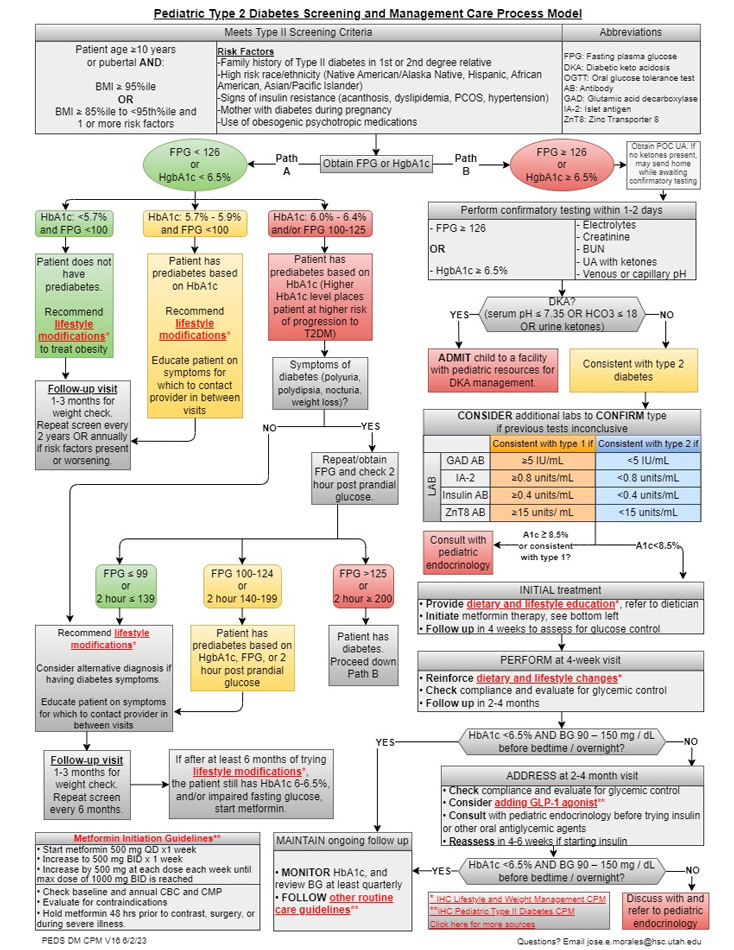Pediatric Type 2 Diabetes Screening & Management Care Process Model
This care process model was developed to help guide the general practitioner on outpatient screening and management of type 2 diabetes in patients within the University of Utah Health and Intermountain Healthcare systems. It was created by general pediatricians at the University of Utah School of Medicine and reviewed by pediatric endocrinologists at Primary Children’s Hospital. It is based on recommendations from the Intermountain Healthcare Pediatric Diabetes Care Process Model and the American Diabetes Association [American: 2021]. In 2023, it was updated to incorporate screening guidelines from the American Academy of Pediatrics Clinical Practice Guideline for the Evaluation and Treatment of Children and Adolescents With Obesity [Hampl: 2023].
Its purpose is to empower the general practitioner to screen for and manage pediatric type 2 diabetes while providing guidance about escalation of care and referral to diabetes specialists. Using the care process model will help primary care clinicians avoid delays in treatment while awaiting specialty consultation and reduce unnecessary referrals.
Key Points
- Patients with BMI ≥95th% percentile for age and sex who are ≥10 years old or pubertal should be screened for type 2 diabetes with a fasting plasma glucose or a HgbA1c.
- Patients with BMI ≥85th% to <95th% percentile for age and sex with ≥1 diabetes risk factors who are ≥10 years old or pubertal should be screened for type 2 diabetes with a fasting plasma glucose or a HgbA1c.
- Patients with obesity, pre-diabetes, and type 2 diabetes should be treated with lifestyle and dietary interventions.
- Patients diagnosed with type 2 diabetes should be initiated on metformin therapy as long as no contraindications exist.
- Patients with HgbA1c in the 6 - 6.4% range or with continued impaired glucose tolerance after 6 months of lifestyle interventions may be started on metformin.
- If fasting plasma glucose or HgbA1c places the patient in the diabetic range, perform recommended lab work to help rule out diabetic ketoacidosis (DKA) and type 1 diabetes.
- Patients with DKA should be emergently referred to a facility with pediatric resources for DKA management.
- Consider adding a GLP-1 agonist in patients with continued HgbA1c elevation and impaired glucose tolerance after starting metformin.
- If considering insulin therapy, consult or refer to pediatric endocrinology.
Click the Care Process Model image above to download a PDF with working links or use the links below.
Please note that on the algorithm phrases in bolded, red text link to Intermountain Healthcare’s Pediatric Clinical Program's "Diagnosis and Treatment of Pediatric Type 2 Diabetes" and "A Primary Care Guide to Lifestyle and Weight Management for Children and Adolescents" care process models and provide further guidance on each topic.
Resources
Information & Support
Related Portal Content
- Type 1 Diabetes
- Missing link with id: 99e6f817.xml
- Obesity in Children &Teens
- Childhood Obesity (FAQ)
- Type 1 Diabetes (FAQ)
For Professionals
American Diabetes Association
Extensive information about genetics, diagnosis, management, research, and possible complications of Type 1, Type 2, and gestational
diabetes.
Services for Patients & Families in Ohio (OH)
| Service Categories | # of providers* in: | OH | NW | Other states (4) (show) | | NM | NV | RI | UT |
|---|---|---|---|---|---|---|---|---|---|
| Diabetes Clinics | 3 | 2 | 1 | 18 | |||||
| Pediatric Endocrinology | 1 | 4 | 6 | 12 | 7 | ||||
For services not listed above, browse our Services categories or search our database.
* number of provider listings may vary by how states categorize services, whether providers are listed by organization or individual, how services are organized in the state, and other factors; Nationwide (NW) providers are generally limited to web-based services, provider locator services, and organizations that serve children from across the nation.
Authors & Reviewers
| Authors: | Jose Morales Moreno, MD |
| Carole H. Stipelman, MD, MPH | |
| Allison Smego, MD |
| 2023: update: Jose Morales Moreno, MDA; Carole H. Stipelman, MD, MPHA; Allison Smego, MDA |
| 2022: update: Jose Morales Moreno, MDA; Carole H. Stipelman, MD, MPHA; Allison Smego, MDA |
| 2022: update: Jose Morales Moreno, MDA; Carole H. Stipelman, MD, MPHA; Allison Smego, MDA |
| 2021: first version: Jose Morales Moreno, MDA; Carole H. Stipelman, MD, MPHA; Allison Smego, MDA |
Page Bibliography
American Diabetes Association Professional Practice Committee.
13. Children and Adolescents: Standards of Medical Care in Diabetes-2021.
Diabetes Care.
2021;44(Suppl 1):S180-S199.
PubMed abstract
The American Diabetes Association (ADA) "Standards of Medical Care in Diabetes" includes the ADA's current clinical practice
recommendations and is intended to provide the components of diabetes care, general treatment goals and guidelines, and tools
to evaluate quality of care.
Hampl SE, Hassink SG, Skinner AC, Armstrong SC, Barlow SE, Bolling CF, Avila Edwards KC, Eneli I, Hamre R, Joseph MM, Lunsford
D, Mendonca E, Michalsky MP, Mirza N, Ochoa ER, Sharifi M, Staiano AE, Weedn AE, Flinn SK, Lindros J, Okechukwu K.
Clinical Practice Guideline for the Evaluation and Treatment of Children and Adolescents With Obesity.
Pediatrics.
2023;151(2).
PubMed abstract / Full Text
This is the American Academy of Pediatrics (AAP)’s first clinical practice guideline (CPG) outlining evidence-based evaluation
and treatment of children and adolescents with overweight and obesity.


 Get More Help in OH
Get More Help in OH

 )
)